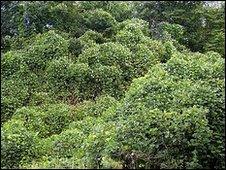Invasive plant 'increases ozone pollution'
- Published

Kudzu quickly smothers surrounding plants, causing them to die
A fast growing invasive plant spreading through south-eastern US has the potential to increase low-level ozone pollution levels, a study has warned.
Researchers found that nitric oxide (NO) emissions, a component in the formation of ozone, doubled in soils where the invasive kudzu was present.
The deep-rooted vine, native to Asia, was introduced in the early 20th Century to help control soil erosion.
The findings appear in the Proceedings of the National Academy of Sciences.
The team of US-based researchers says it is the first study to quantify a link between an invasive plant and a reduction in air quality.
-spl.jpg)
The vines grow very rapidly - up to 26cm in 24 hours
"The observed doubling of NO emissions under kudzu (Pueraria montana) in Georgia suggests that kudzu invasion could increase regional ozone concentrations as the plant continues to spread through its current range," they wrote.
Co-author Jonathan Hickman, a research fellow from The Earth Institute at Columbia University, New York, explained that the alien species potential to increase ozone levels stemmed from the fact that it was a "nitrogen-fixing" plant.
"It is able to take atmospheric nitrogen and convert it - with the help of bacteria that live inside the plants roots in a symbiotic relationship - into a form that the plant can use for its own nutritional purposes," he explained.
"Essentially, it is a new source of nitrogen entering the ecosystem because atmospheric nitrogen is otherwise unavailable for plants to use."
However, when the plant's leaves die, fall off and decompose, all the nitrogen locked within them is released into the soil.
"When the leaves' tissues break down, the nitrogen is changed from one form to another by bacteria in the soil, and there are two key transformations - we call this the soil nitrogen cycle," he told BBC News.
"There are a couple of components in the soil nitrogen cycle where nitric oxide is emitted as a by-product."
The team said kudzu covered about three million hectares, and was expanding its reach by about 50,000 hectares each year.
"Kudzu coverage in the southeastern US exceeds that of cultivated soybean, making it the dominant nitrogen-fixing plant in the region.
Using data collected from soil samples, the research team ran an extreme scenario - where kudzu covered all non-urban and non-agricultural soils in the species' range by 2050 - through a "chemical transport" model.
The findings suggested that the plants' NOx emissions could result in a 35% increase in the number of days when ozone levels exceeded the upper threshold set by the US Environment Protection Agency.
However, Dr Hickman was keen to express that the scenario was created to illustrate the plants' ability to contribute to the formation of ozone, rather than being based on projections of what was expected to happen in the future.
He acknowledged that any soil used to grow nitrogen-fixing plants or were fertilised for agricultural reasons would result in an increase in gases involved in the formation of ozone.
"But in those cases, we are doing these things for necessary reasons - namely food production," he observed.
"In the case of Kudzu, it is an undersirable plant that is spreading over a large area in the south-east US."
Aggressive alien
While the ozone layer in the upper atmosphere plays an important role in limiting harmful ultraviolet light reaching the Earth's surface, low-level ozone is a pollutant that is harmful, causing respiratory problems in animals as well as well-documented cases in humans.
Writing in the journal Nature in 2007, researchers found that concentrations of the greenhouse gas near the ground also damaged plants sensitive to the gas, reducing their effectiveness to absorb carbon dioxide.
Ozone enters the plants through pores in the leaves. It interferes with the reactions involved in photosynthesis, which is the process in which the plants produce the sugars to fuel their growth, leaving the plants weakened.
Kudzu, a member of the pea family, is native to south-eastern Asia. Its network of deep roots, which make up more than half of the plant's biomass, makes it difficult to control with herbicides. The semi-woody stems can extend to 30m in length.
According to the IUCN's Invasive Species Specialist Group, the plant has recently become "established and invasive in Europe", affecting parts of Italy and Switzerland.
Although its natural habitat is broadleafed or mixed forests, it can spread quickly through managed landscapes such as pastures, rail embankments and river banks.
It it able to grow rapidly - up to 26cm a day - because it concentrates on extending its growth shoots rather than expending energy on developing support structures. It uses the existing habitat instead.
"Few plants can survive once smothered by kudzu and small ecosystems could be radically altered," a 2007 report by the European Plant Protection Organization concluded.
"The plant quickly develops, rapidly covering the soil, affecting indigenous plants and completely modifying the structure of the ecosystem."
Dr Hickman hoped the findings would raise awareness of a novel impact of invasive species.
"It is an area where the impact of invasive species have not been considered much," he said.
"Simply taking this first step gets people to think about the impacts of these species on the atmosphere."